light YAMAHA CYGNUS L 2012 User Guide
[x] Cancel search | Manufacturer: YAMAHA, Model Year: 2012, Model line: CYGNUS L, Model: YAMAHA CYGNUS L 2012Pages: 76, PDF Size: 1.56 MB
Page 32 of 76

OPERATION AND IMPORTANT RIDING POINTS
5-1
5
EAU15951
Read the Owner’s Manual carefully to
become familiar with all controls. If
there is a control or function you do not
understand, ask your Yamaha dealer.
WARNING
EWA10271
Failure to familiarize yourself with
the controls can lead to loss of con-
trol, which could cause an accident
or injury.
EAUT1865
Starting the engine NOTICE
ECA10250
See page 5-3 for engine break-in in-
structions prior to operating the ve-
hicle for the first time.In order for the ignition circuit cut-off
system to enable starting, the side-
stand must be up.
See page 3-12 for more information.
1. Turn the key to “ON”.
The engine trouble warning light
should come on for a few seconds,
then go off. NOTICE: If the warn-
ing light does not go off, have a
Yamaha dealer check its electri-
cal circuit.
[ECAT1120]
2. Close the throttle completely.
3. Start the engine by pushing the
start switch while applying the front
or rear brake.
If the engine does not start, re-
lease the start switch, wait a few
seconds, and then try again. Each
starting attempt should be as short
as possible to preserve the bat-
tery. Do not crank the engine more
than 5 seconds on any one at-tempt. If the engine does not start
with the starter motor, try using the
kickstarter.
NOTICE
ECA11042
For maximum engine life, never ac-
celerate hard when the engine is
cold!
U1RSE0E0.book Page 1 Tuesday, October 18, 2011 8:56 AM
Page 34 of 76

OPERATION AND IMPORTANT RIDING POINTS
5-3
5
EAU16820
Tips for reducing fuel con-
sumption Fuel consumption depends largely on
your riding style. Consider the following
tips to reduce fuel consumption:●
Avoid high engine speeds during
acceleration.
●
Avoid high engine speeds with no
load on the engine.
●
Turn the engine off instead of let-
ting it idle for an extended length of
time (e.g., in traffic jams, at traffic
lights or at railroad crossings).
EAU16830
Engine break-in There is never a more important period
in the life of your engine than the period
between 0 and 1000 km (600 mi). For
this reason, you should read the follow-
ing material carefully.
Since the engine is brand new, do not
put an excessive load on it for the first
1000 km (600 mi). The various parts in
the engine wear and polish themselves
to the correct operating clearances.
During this period, prolonged full-throt-
tle operation or any condition that might
result in engine overheating must be
avoided.
EAU45582
0–150 km (0–90 mi)
Avoid prolonged operation above 1/3
throttle.
150–500 km (90–300 mi)
Avoid prolonged operation above 1/2
throttle.
U1RSE0E0.book Page 3 Tuesday, October 18, 2011 8:56 AM
Page 41 of 76
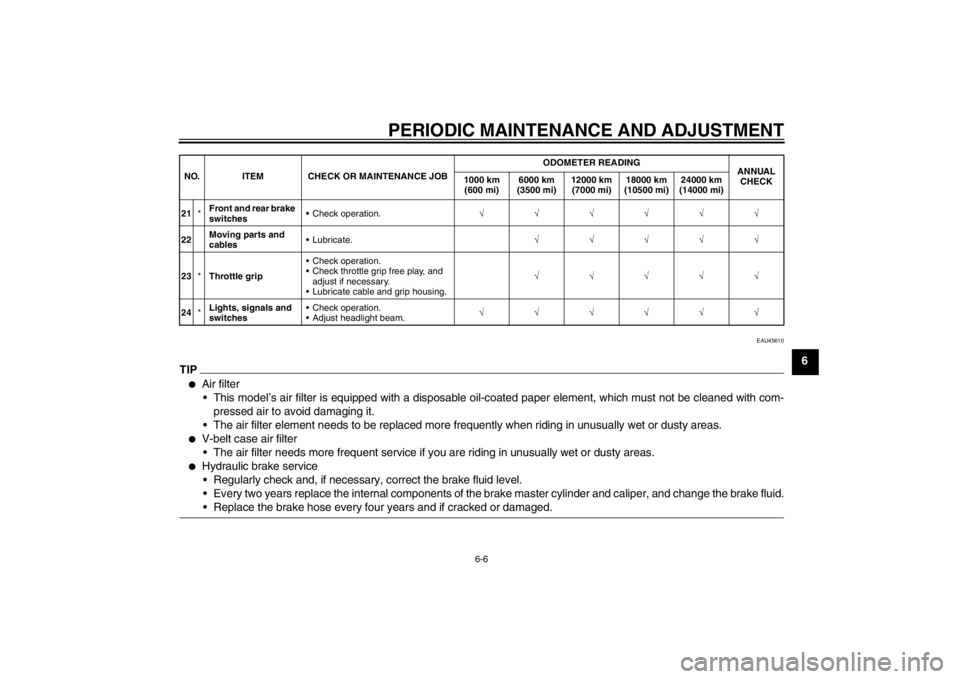
PERIODIC MAINTENANCE AND ADJUSTMENT
6-6
6
EAU45610
TIP●
Air filter
This model’s air filter is equipped with a disposable oil-coated paper element, which must not be cleaned with com-
pressed air to avoid damaging it.
The air filter element needs to be replaced more frequently when riding in unusually wet or dusty areas.
●
V-belt case air filter
The air filter needs more frequent service if you are riding in unusually wet or dusty areas.
●
Hydraulic brake service
Regularly check and, if necessary, correct the brake fluid level.
Every two years replace the internal components of the brake master cylinder and caliper, and change the brake fluid.
Replace the brake hose every four years and if cracked or damaged.
21*Front and rear brake
switches Check operation.√√√√√√
22Moving parts and
cables Lubricate.√√√√√
23*Throttle grip Check operation.
Check throttle grip free play, and
adjust if necessary.
Lubricate cable and grip housing.√√√√√
24*Lights, signals and
switches Check operation.
Adjust headlight beam.√√√√√√ NO. ITEM CHECK OR MAINTENANCE JOBODOMETER READING
ANNUAL
CHECK 1000 km
(600 mi)6000 km
(3500 mi)12000 km
(7000 mi)18000 km
(10500 mi)24000 km
(14000 mi)
U1RSE0E0.book Page 6 Tuesday, October 18, 2011 8:56 AM
Page 43 of 76
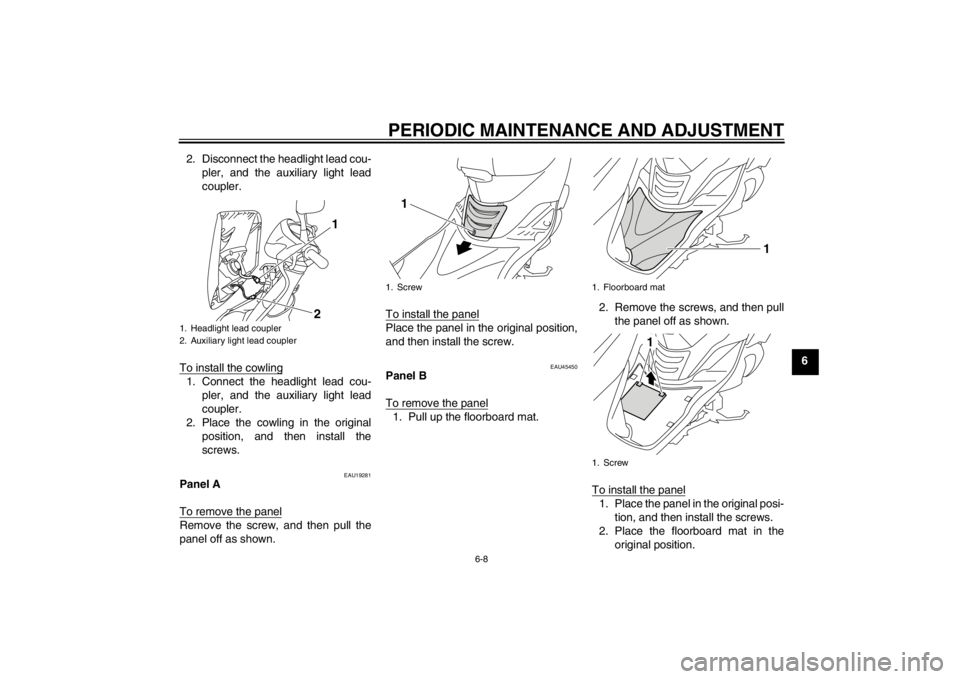
PERIODIC MAINTENANCE AND ADJUSTMENT
6-8
6 2. Disconnect the headlight lead cou-
pler, and the auxiliary light lead
coupler.
To install the cowling
1. Connect the headlight lead cou-
pler, and the auxiliary light lead
coupler.
2. Place the cowling in the original
position, and then install the
screws.
EAU19281
Panel A
To remove the panelRemove the screw, and then pull the
panel off as shown.To install the panel
Place the panel in the original position,
and then install the screw.
EAU45450
Panel B
To remove the panel1. Pull up the floorboard mat.2. Remove the screws, and then pull
the panel off as shown.
To install the panel
1. Place the panel in the original posi-
tion, and then install the screws.
2. Place the floorboard mat in the
original position.
1. Headlight lead coupler
2. Auxiliary light lead coupler
1
2
1. Screw
1
1. Floorboard mat
1. Screw
1
1
U1RSE0E0.book Page 8 Tuesday, October 18, 2011 8:56 AM
Page 44 of 76
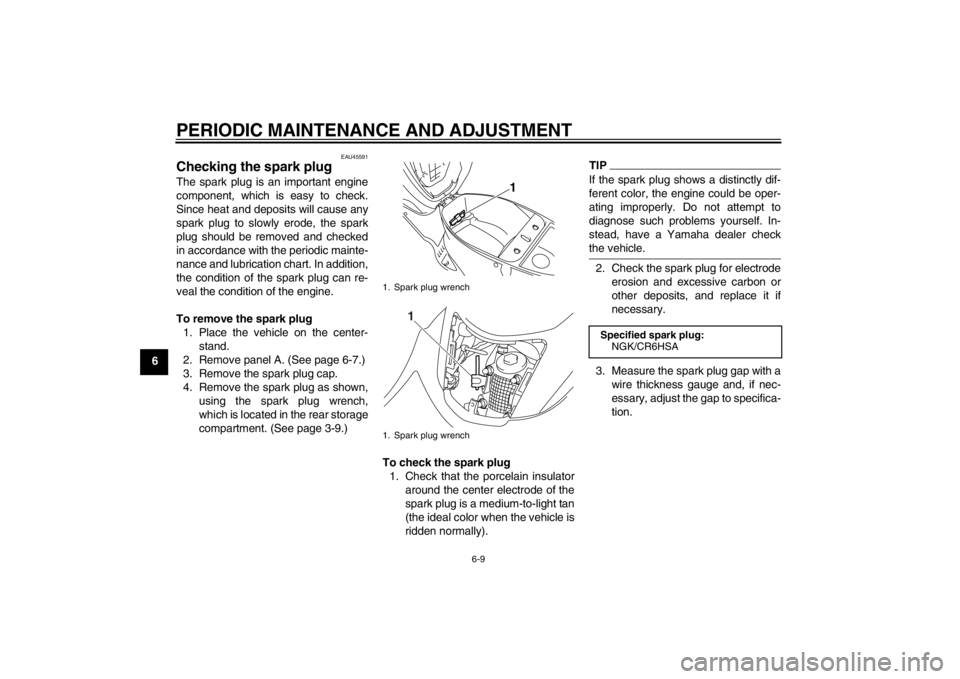
PERIODIC MAINTENANCE AND ADJUSTMENT
6-9
6
EAU45591
Checking the spark plug The spark plug is an important engine
component, which is easy to check.
Since heat and deposits will cause any
spark plug to slowly erode, the spark
plug should be removed and checked
in accordance with the periodic mainte-
nance and lubrication chart. In addition,
the condition of the spark plug can re-
veal the condition of the engine.
To remove the spark plug
1. Place the vehicle on the center-
stand.
2. Remove panel A. (See page 6-7.)
3. Remove the spark plug cap.
4. Remove the spark plug as shown,
using the spark plug wrench,
which is located in the rear storage
compartment. (See page 3-9.)
To check the spark plug
1. Check that the porcelain insulator
around the center electrode of the
spark plug is a medium-to-light tan
(the ideal color when the vehicle is
ridden normally).
TIPIf the spark plug shows a distinctly dif-
ferent color, the engine could be oper-
ating improperly. Do not attempt to
diagnose such problems yourself. In-
stead, have a Yamaha dealer check
the vehicle.2. Check the spark plug for electrode
erosion and excessive carbon or
other deposits, and replace it if
necessary.
3. Measure the spark plug gap with a
wire thickness gauge and, if nec-
essary, adjust the gap to specifica-
tion.
1. Spark plug wrench
1. Spark plug wrench
1
1
Specified spark plug:
NGK/CR6HSA
U1RSE0E0.book Page 9 Tuesday, October 18, 2011 8:56 AM
Page 45 of 76

PERIODIC MAINTENANCE AND ADJUSTMENT
6-10
6 To install the spark plug
1. Clean the surface of the spark plug
gasket and its mating surface, and
then wipe off any grime from the
spark plug threads.
2. Install the spark plug with the
spark plug wrench, and then tight-
en it to the specified torque.
TIPIf a torque wrench is not available when
installing a spark plug, a good estimate
of the correct torque is 1/4–1/2 turn
past finger tight. However, the spark
plug should be tightened to the speci-
fied torque as soon as possible.3. Install the spark plug cap.
4. Install the panel.
EAU53150
Engine oil The engine oil level should be checked
before each ride. In addition, the oil
must be changed at the intervals spec-
ified in the periodic maintenance and
lubrication chart.
To check the engine oil level
1. Place the vehicle on the center-
stand. A slight tilt to the side can
result in a false reading.
2. Start the engine, warm it up for
several minutes, and then turn it
off.
3. Wait a few minutes until the oil set-
tles, remove the engine oil filler
cap, wipe the engine oil dipstick
clean, insert it back into the oil filler
hole (without screwing it in), and
then remove it again to check the
oil level.TIPThe engine oil should be between the
minimum and maximum level marks.
1. Spark plug gapSpark plug gap:
0.6–0.7 mm (0.024–0.028 in)
Tightening torque:
Spark plug:
13 Nm (1.3 m·kgf, 9.4 ft·lbf)
U1RSE0E0.book Page 10 Tuesday, October 18, 2011 8:56 AM
Page 61 of 76
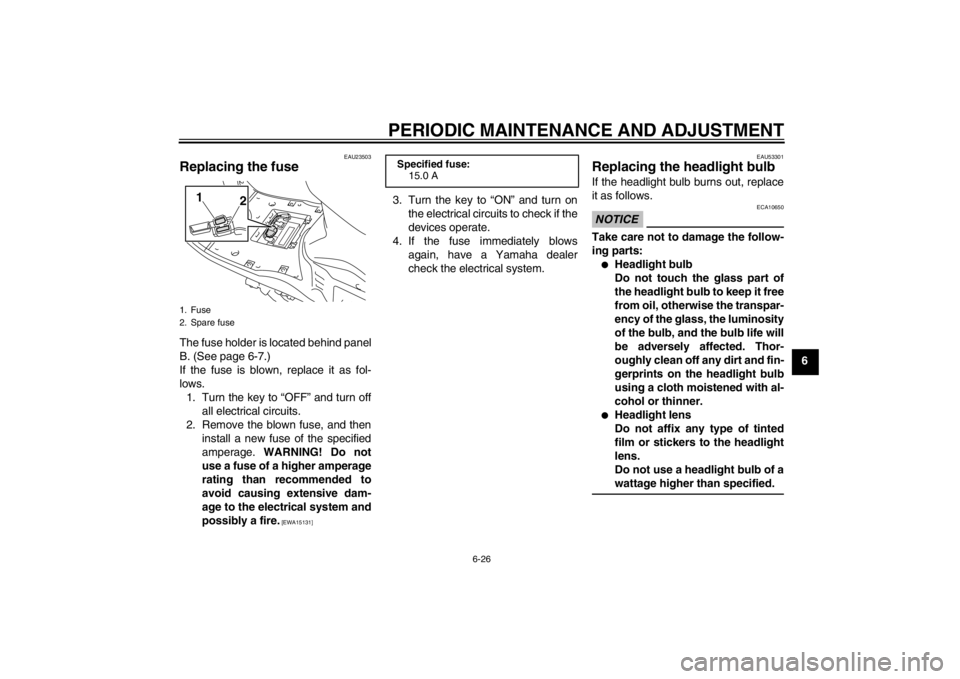
PERIODIC MAINTENANCE AND ADJUSTMENT
6-26
6
EAU23503
Replacing the fuse The fuse holder is located behind panel
B. (See page 6-7.)
If the fuse is blown, replace it as fol-
lows.
1. Turn the key to “OFF” and turn off
all electrical circuits.
2. Remove the blown fuse, and then
install a new fuse of the specified
amperage. WARNING! Do not
use a fuse of a higher amperage
rating than recommended to
avoid causing extensive dam-
age to the electrical system and
possibly a fire.
[EWA15131]
3. Turn the key to “ON” and turn on
the electrical circuits to check if the
devices operate.
4. If the fuse immediately blows
again, have a Yamaha dealer
check the electrical system.
EAU53301
Replacing the headlight bulb If the headlight bulb burns out, replace
it as follows.NOTICE
ECA10650
Take care not to damage the follow-
ing parts:●
Headlight bulb
Do not touch the glass part of
the headlight bulb to keep it free
from oil, otherwise the transpar-
ency of the glass, the luminosity
of the bulb, and the bulb life will
be adversely affected. Thor-
oughly clean off any dirt and fin-
gerprints on the headlight bulb
using a cloth moistened with al-
cohol or thinner.
●
Headlight lens
Do not affix any type of tinted
film or stickers to the headlight
lens.
Do not use a headlight bulb of a
wattage higher than specified.
1. Fuse
2. Spare fuse
1
2
Specified fuse:
15.0 A
U1RSE0E0.book Page 26 Tuesday, October 18, 2011 8:56 AM
Page 62 of 76
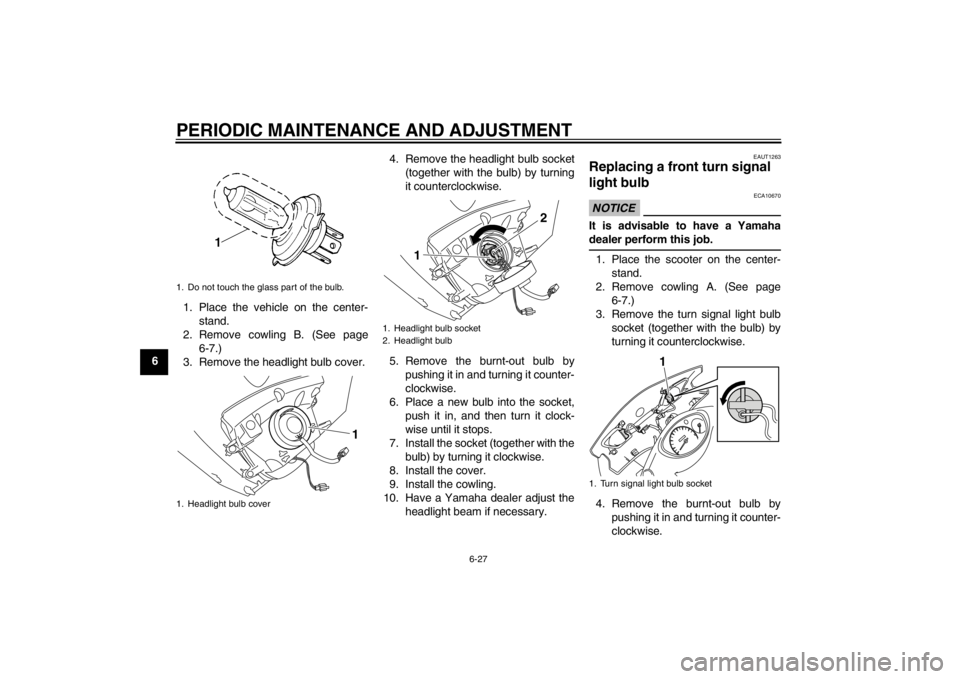
PERIODIC MAINTENANCE AND ADJUSTMENT
6-27
61. Place the vehicle on the center-
stand.
2. Remove cowling B. (See page
6-7.)
3. Remove the headlight bulb cover.4. Remove the headlight bulb socket
(together with the bulb) by turning
it counterclockwise.
5. Remove the burnt-out bulb by
pushing it in and turning it counter-
clockwise.
6. Place a new bulb into the socket,
push it in, and then turn it clock-
wise until it stops.
7. Install the socket (together with the
bulb) by turning it clockwise.
8. Install the cover.
9. Install the cowling.
10. Have a Yamaha dealer adjust the
headlight beam if necessary.
EAUT1263
Replacing a front turn signal
light bulb NOTICE
ECA10670
It is advisable to have a Yamaha
dealer perform this job.1. Place the scooter on the center-
stand.
2. Remove cowling A. (See page
6-7.)
3. Remove the turn signal light bulb
socket (together with the bulb) by
turning it counterclockwise.
4. Remove the burnt-out bulb by
pushing it in and turning it counter-
clockwise.
1. Do not touch the glass part of the bulb.
1. Headlight bulb cover
1
1. Headlight bulb socket
2. Headlight bulb
2
1
1. Turn signal light bulb socket
1
U1RSE0E0.book Page 27 Tuesday, October 18, 2011 8:56 AM
Page 63 of 76
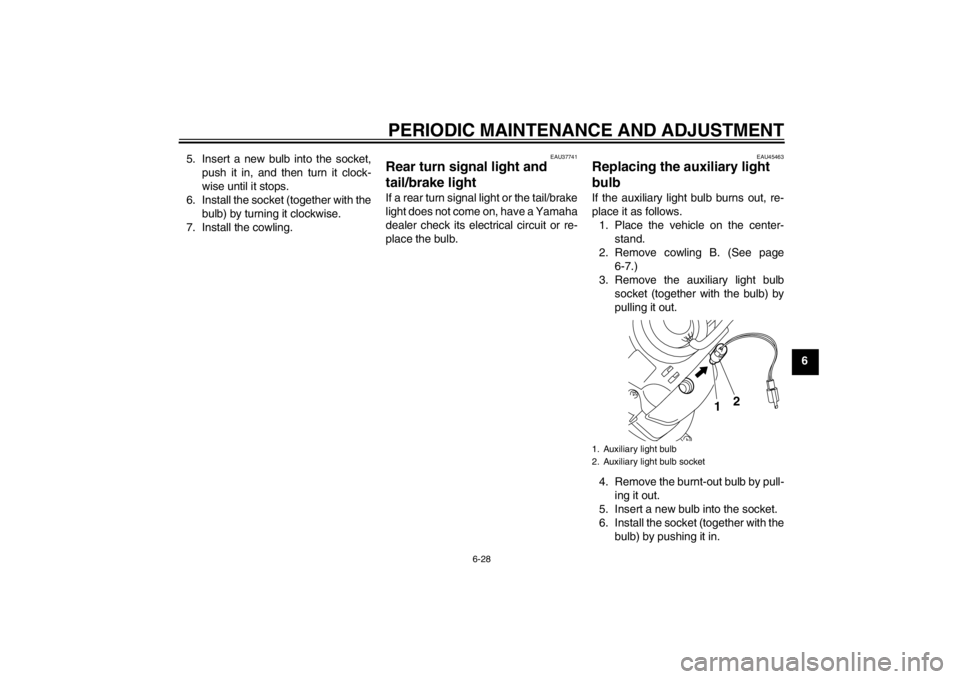
PERIODIC MAINTENANCE AND ADJUSTMENT
6-28
6 5. Insert a new bulb into the socket,
push it in, and then turn it clock-
wise until it stops.
6. Install the socket (together with the
bulb) by turning it clockwise.
7. Install the cowling.
EAU37741
Rear turn signal light and
tail/brake light If a rear turn signal light or the tail/brake
light does not come on, have a Yamaha
dealer check its electrical circuit or re-
place the bulb.
EAU45463
Replacing the auxiliary light
bulb If the auxiliary light bulb burns out, re-
place it as follows.
1. Place the vehicle on the center-
stand.
2. Remove cowling B. (See page
6-7.)
3. Remove the auxiliary light bulb
socket (together with the bulb) by
pulling it out.
4. Remove the burnt-out bulb by pull-
ing it out.
5. Insert a new bulb into the socket.
6. Install the socket (together with the
bulb) by pushing it in.1. Auxiliary light bulb
2. Auxiliary light bulb socket
12
U1RSE0E0.book Page 28 Tuesday, October 18, 2011 8:56 AM
Page 64 of 76
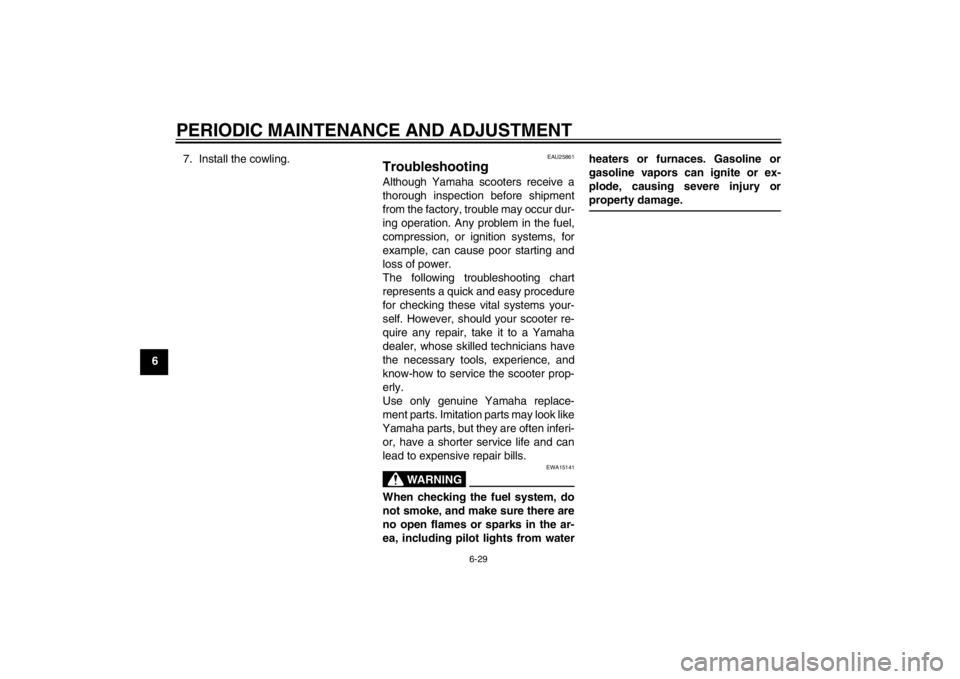
PERIODIC MAINTENANCE AND ADJUSTMENT
6-29
67. Install the cowling.
EAU25861
Troubleshooting Although Yamaha scooters receive a
thorough inspection before shipment
from the factory, trouble may occur dur-
ing operation. Any problem in the fuel,
compression, or ignition systems, for
example, can cause poor starting and
loss of power.
The following troubleshooting chart
represents a quick and easy procedure
for checking these vital systems your-
self. However, should your scooter re-
quire any repair, take it to a Yamaha
dealer, whose skilled technicians have
the necessary tools, experience, and
know-how to service the scooter prop-
erly.
Use only genuine Yamaha replace-
ment parts. Imitation parts may look like
Yamaha parts, but they are often inferi-
or, have a shorter service life and can
lead to expensive repair bills.
WARNING
EWA15141
When checking the fuel system, do
not smoke, and make sure there are
no open flames or sparks in the ar-
ea, including pilot lights from waterheaters or furnaces. Gasoline or
gasoline vapors can ignite or ex-
plode, causing severe injury or
property damage.
U1RSE0E0.book Page 29 Tuesday, October 18, 2011 8:56 AM